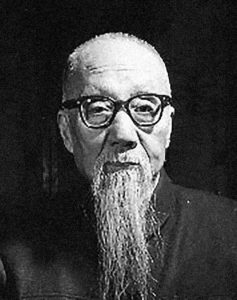
History and presence of chambers of commerce and industry associations in China
Friend or foe? How to cooperate in one organisation with a competitor, that, in the market, threatens the very existence of your company? Think of the Taiji symbol. In Chinese philosophy, things are rarely absolute. Competition and cooperation are interwoven; but these two seemingly antagonistic concepts develop in interrelated ways, creating new ideas and opportunities, contributing to the prosperity of both companies and society as a whole.
Business, in China as anywhere else in the world, was and is never smooth and easy. Both in ancient times and nowadays, nature could be hostile (COVID-19), while the business environment and government attitude to private entrepreneurship was sometimes very supportive, sometimes obstructive. Volker Müller, Senior Business Manager at the European Chamber, tells us how the mission of chambers of commerce and industry associations has remained basically the same over the centuries: mutual support, solving practical problems, sharing expertise, getting the voice of industry heard and providing members with a safe haven in a tough environment.
Ancient Times
Can you imagine surviving in pre-industrial times in the Tibetan highlands without drinking tea? From the Tang Dynasty (seventh to ninth centuries) until the early 20th century, caravans undertook a half-year journey to transport vital tea from the hills of central Yunnan via Lijiang to the slopes of the Himalaya, where they exchanged it for valuable Tibetan horses, returning the next year. The ‘Tea- and Horse Road’ was born, one of several trading routes complementing the famous Silk Road.
Merchants could not conquer this life-threatening terrain alone, so different professions—tea, gold, cloth, traditional medicine and many more—formed guilds, an early form of industrial organisations.[1] In many cases, professions were closely related to a certain area of China, making professional and regional bonds indistinguishable; for example, craftsman from Dingzhou in Fujian Province had a quasi-monopoly in paper-manufacturing. Successful merchants built lavishly decorated guildhalls in all major towns in China, but also along the major international trade routes. In the Ming Dynasty, up to 400 guildhalls existed in Beijing alone, organising members, helping them with administrative and legal burdens—local regulations were often very different from those in their home province—and creating a sense of community.[2] Not very different from that what a chamber of commerce does today.

Late Qing Dynasty and the Republic of China
In modern times, the first Chinese Chamber of Commerce was founded on 22nd February 1902 in Shanghai. After the invasion of the eight imperial powers in 1901, China’s Qing Government was forced to re-negotiate international trade treaties. Chinese companies had no voice in these negotiations, motivating the foundation of their own chamber of commerce. Their statutes and organisational structure imitated the Japanese Chamber of Commerce in Shanghai. In 1904, the Qing Government officially recognised chambers of commerce, triggering the foundation of several chambers in coastal towns and provinces like Tianjin and Fujian. By 1912, the number of Chinese chambers of commerce had already grown to 969, plus 39 foreign chambers founded by overseas Chinese.[3]
This rapid development came to an abrupt end in 1927 after Chiang Kai-Shek’s coup. In the beginning, the influential Shanghai and other chambers of commerce had supported Chiang Kai-Shek, hoping to curb the Shanghai labour movement. However, the chambers’ members’ interests soon clashed with the Guomindang policies, leading in 1929/30 to the independent chambers being dissolved and replaced by Guomindang-controlled ones. Over the next two decades, in the midst of war and China’s economic collapse, chambers of commerce continued to exist but were limited to very basic activities.[4]
The new China
The first years after the foundation of the People’s Republic of China were characterised by a mixed economy, the ‘New Democracy’. In October 1951, in his political report to the Political Consultative Conference, Premier Zhou Enlai encouraged the development of chambers of commerce, resulting in the foundation of the umbrella organisation All China Chamber of Industry and Commerce (CFIC) in October 1953.

However, the revival of chambers of commerce lasted only a few years; from 1956–1959, the CFIC used its influence to urge private companies to merge into the socialist, state-driven economy.[5]
Immediately after the founding of the People’s Republic, most foreign companies retreated from China, but—a little-known fact—a core group of foreign business people continued to operate in the country. In 1958, during the Great Leap Forward, two German journalists visited China.[6] In Shanghai, they met a community of about 100 foreigners who had founded an international business club.
The reform era
After being dormant in China for almost 20 years, the chambers of commerce revived quickly with the beginning of economic reforms. As early as October 1977, the Central Committee of the Communist Party of China issued a decree that “all democratic parties and chambers of commerce should rebuild and re-start their activities.”[7] The CFIC held its first national conferences in October 1979 and November 1983, amending its statutes to pave the way for a renewed representation of private business in China.
Today, chambers of commerce and industry associations are indispensable parts of China’s business environment. By January 2019, a staggering 38,100 such organisations were registered.[8] In 2018, the Ministry of Civil Affairs listed 18 foreign chambers and the Hong Kong Chamber of Commerce as registered in China.[9] In addition, a growing number of international industry associations are establishing representation in China.[10]
Most Chinese organisations are based in a small region¸ reflecting characteristic Chinese ‘local patriotism’. To take one example: the region Chaoshan (潮汕) in Eastern Guangdong, comprising the cities of Shantou, Chaozhou, Shanwei and Jieyang, is culturally and economically very different from the prosperous Pearl River Delta. A network of 410 Chaoshan Chambers of Commerce have been set up all over China, advocating for the special interests of their regional enterprises.
Chinese chambers of commerce and industry organisations may either be founded by government agencies or independently on the initiative of enterprises. In both cases, government and private business often form a symbiosis – the private economy helping the government achieve its growth targets and the government solving problems for the industry. Governments may even delegate certain tasks to industry organisations, for example, compiling a catalogue of all medical devices on the market, using the joint expertise of enterprises and industry associations.
A recent tendency—probably possible only in digital-savvy China—is e-industry organisations, registered or informal, without a physical presence, only operating online and in chat-groups.[11]
Multinational companies (MNCs) have learnt to successfully navigate the complex Chinese ‘ecosystem’ of chambers of commerce and industry associations. Many MNCs are parallel members in several foreign and Chinese organisations, using whichever advocacy channel fits best for a given challenge.
The success story of the European Chamber of
Commerce in China would not have been possible without an environment that
values the contribution of private industry to the wellbeing of the society, or
without a cultural background of fierce competitors also being partners, a
mindset that has been growing over centuries.
[1] Hong, Chen: Across Tibet (in Chinese), China Tourism Publishing House, Beijing 2013, p. 308ff
[2] Ulrich, Theobald: Guild Halls, ChinaKnowledge, 2016, viewed 15th September 2020, <http://chinaknowledge.de/History/Terms/huiguan.html>
[3] Yu, Heping: A Brief History of Chamber of Commerce in China (in Chinese), Social Sciences Academic Press, Beijing, 2011, p. 12ff
[4] Ibid, p. 147ff
[5] All China Chamber of Industry and Commerce (in Chinese), Baidu Encyclopaedia, viewed 15th September 2020, <https://baike.baidu.com/item/%E4%B8%AD%E5%8D%8E%E5%85%A8%E5%9B%BD%E5%B7%A5%E5%95%86%E4%B8%9A%E8%81%94%E5%90%88%E4%BC%9A/1691739?fromtitle=%E5%85%A8%E5%9B%BD%E5%B7%A5%E5%95%86%E8%81%94%E5%90%88%E4%BC%9A&fromid=16956473&fr=aladdin>
[6] Gillhausen, R. and Heldt, J: Unheimliches China (in German), Nannen Publishing House, Hamburg, 1959.
[7] Zhang, Tiejun: The Study of the Chamber of Commerce in China after Reform and Opening (in Chinese), PhD thesis, Northeastern Pedagogical University, p. 26
[8] Xu, Jianwei and Huang, Dehai: Mapping the Research on China’s Chambers of Commerce (in Chinese), Organisation and Strategy, June 2019, page 39, viewed 10th September 2019, China Academic Journal Electronic Publishing House, item 1003-1154(2019)06-0038-11
[9] Result of the Annual Audit of Foreign Chambers of Commerce, Ministry of Civil Affairs, 23rd August 2018, viewed 15th September 2020, <https://baike.baidu.com/reference/23493936/126dCrQ7mc8mtbqPZDMNZXgBuEVtEsnu5KbOnlx1i0EJR1d18yoU0kTT7r0OnL9fXq10jP46HoGGb1MGX08vWufn_8OLHs-gXQloq3Qf>
[10] There are more foreign chambers of commerce active in China than registered at the Ministry of Civil Affairs, e.g. some chambers use a company as their legal form. Trade associations without income often opt to establish the legal form of a representative office.
[11] Heberer, T. and Müller, A.: Entwicklungsstaat China (German), 2020, viewed 15th September 2020, <http://library.fes.de/pdf-files/iez/16040.pdf>, p. 30ff.


Recent Comments